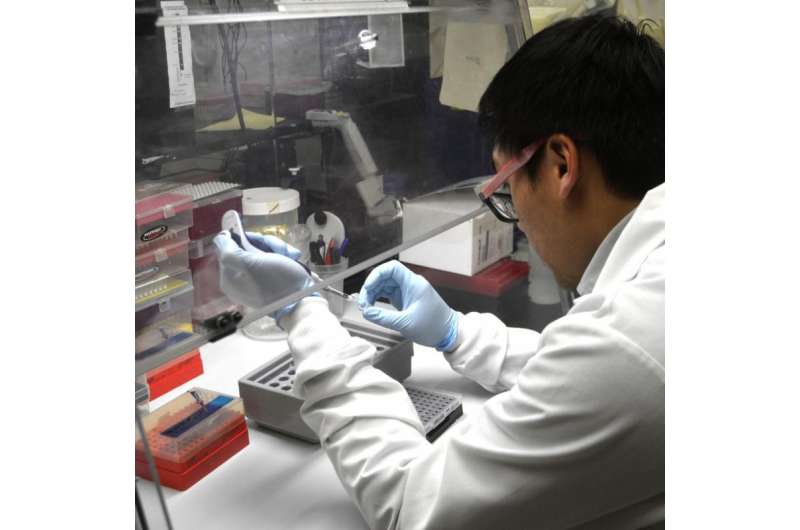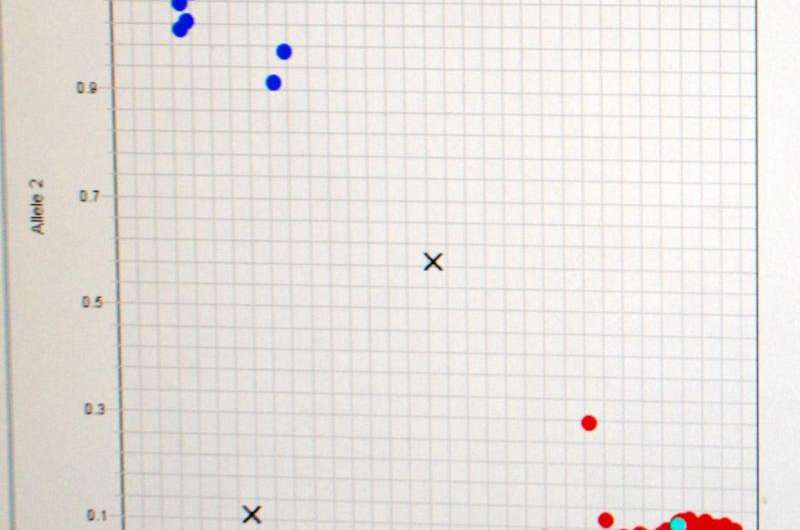New wheat streak mosaic virus resistance genetic markers developed

The Wsm2 gene is located on chromosome 3BS in wheat and most recently eight tightly linked flanking markers have been identified and mapped.
To most, that means very little. To Texas A&M AgriLife Research geneticists and breeders, it's the key to battling one of the most important biotic stresses affecting wheat.
Dr. Shuyu Liu, AgriLife Research small grains geneticist in Amarillo, and his team recently published two articles, "Saturated Genetic Mapping of Wheat Streak Mosaic Virus Resistance Gene Wsm2 in Wheat" and "Development and Validation of KASP Markers for Wheat Streak Mosaic Virus Resistance Gene Wsm2," in the Crop Science journal.
In both articles, Liu and his collaborators outlined how wheat streak mosaic virus, also known as WSMV, is a major threat to wheat production in the Great Plains, one of the largest wheat regions in the nation, Liu said. While the threat may not be as high as it is in the U.S., the virus has been found in all major wheat-growing regions of the world.
There is no effective chemical treatment available for the disease, he said. Host resistance is the most cost-effective and environmentally safe approach for combating this disease.
"WSMV resistance is an important target trait for our wheat breeding program," said Dr. Jackie Rudd, AgriLife Research wheat breeder in Amarillo. "We have evaluated many diverse sources of genetic resistance over the years, including a wheat breeding line from Colorado State University, CO960293-2, known to have good resistance."
Rudd and the AgriLife Research wheat team began crossing with the Colorado line in 2005 and by 2011 had identified and mapped WSMV resistance on chromosome 3BS and named the gene Wsm2.
Liu said wheat breeding programs worldwide now rely on two primary sources of resistance, Wsm1 – identified in the early 1990s from a wheatgrass, and the Wsm2 from a bread wheat, for development of WSMV-resistant wheat cultivars.
Effective molecular markers closely linked to the target genes are the key for the success of marker-assisted selection on traits such as WSMV resistance, he said. Among the available markers, single nucleotide polymorphisms or SNPs are routinely used in plant breeding programs to distinguish potentially superior genotypes with genetic merit for traits of interest.

His genetic team has identified eight SNPs flanking Wsm2, Liu said. This helps increase the efficiency in selection for the resistance needed to battle the virus.
"A single marker linked to target genes may not be sufficient to screen across diverse genetic backgrounds," Liu said. "Therefore, a set of tightly linked markers on each side of the gene is the best predictor for Wsm2 with higher accuracy."
These tightly linked SNPs will be useful for marker-assisted selection for WSMV resistance, he said.
Dr. Chor Tee Tan, an associate research scientist in Amarillo, has been able to carry the AgriLife Research work one step further. Working in the wheat genetic program for almost four years, he led the effort to develop breeder-friendly Kompetitive Allele Specific Polymerase Chain Reaction or KASP assays for those SNPs tightly linked to Wsm2 and validated them in multiple breeding populations.
If a breeder is screening 1,000s of breeding lines, as is typical, the KASP acts as a flag to say the necessary sequence for wheat streak mosaic virus resistance exists in a particular line of wheat, Tan said.
"These KASP SNPs were tested on a panel of nine wheat breeding and mapping populations with diverse genetic backgrounds and were found to be very effective in differentiating resistant and susceptible genotypes for WSMV," he said.
"We have many lines with Wsm2 in our breeding pipeline now and these new markers will help us get to the finish line," Rudd said. "Marker technology has greatly improved, and these latest findings are easy to use and very predictable."
Liu said the joint effort from breeders at AgriLife Research, Kansas State University-Hays and Colorado State University, has "made great progress to fight this disease that is not easy to screen by infection."
Research for these studies was supported in part by the Texas Wheat Producer Board, Monsanto's Beachell-Borlaug International Scholars, AgriLife Research and a U.S. Department of Agriculture National Institute of Food and Agriculture grant to the Triticeae-CAP project.
More information: Silvano Assanga et al. Saturated Genetic Mapping ofResistance Genein Wheat, Crop Science (2017). DOI: 10.2135/cropsci2016.04.0233
Chor-Tee Tan et al. Development and Validation of KASP Markers for Wheat Streak Mosaic Virus Resistance Gene, Crop Science (2017). DOI: 10.2135/cropsci2016.04.0234
Provided by Texas A&M University




















